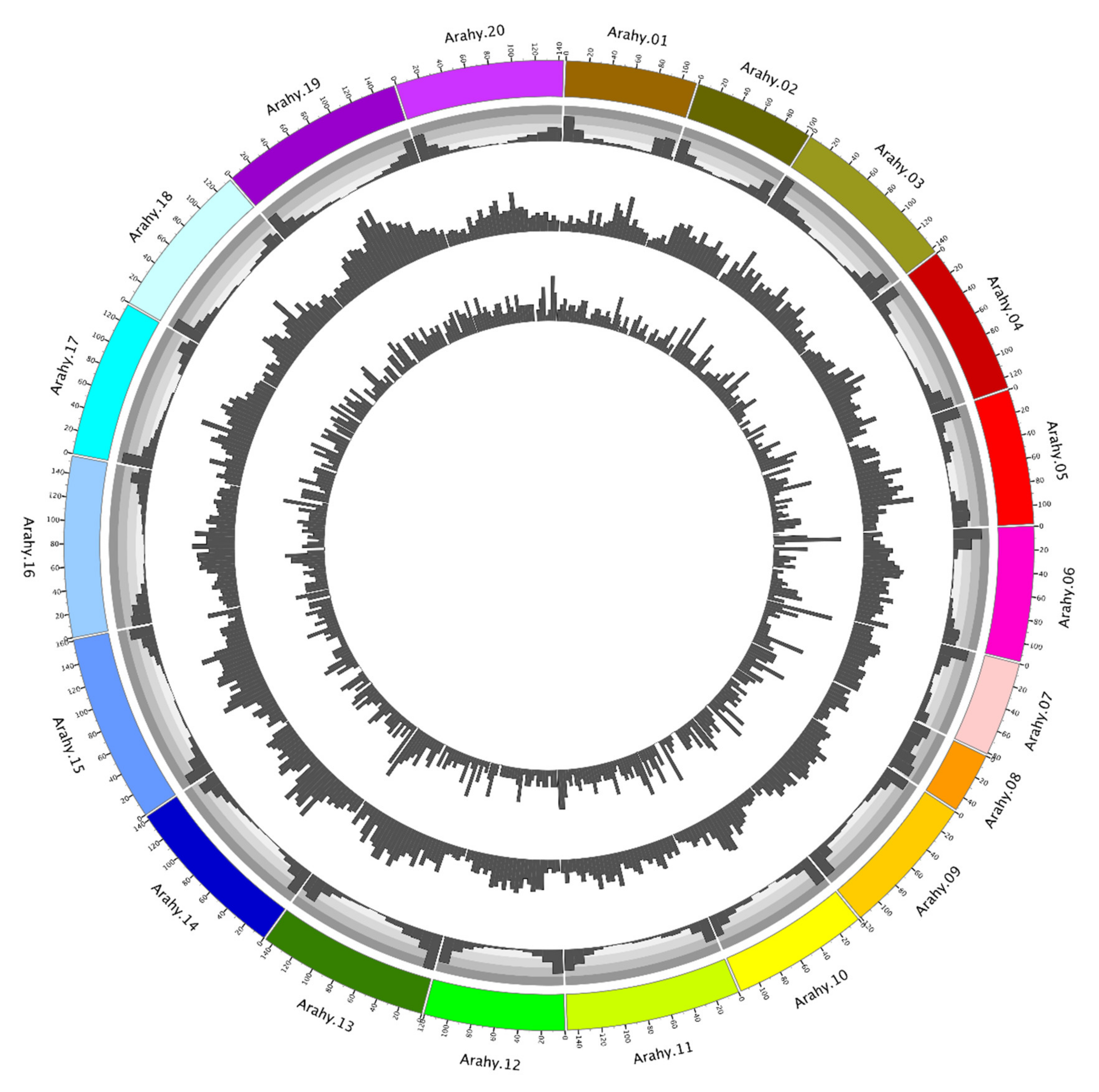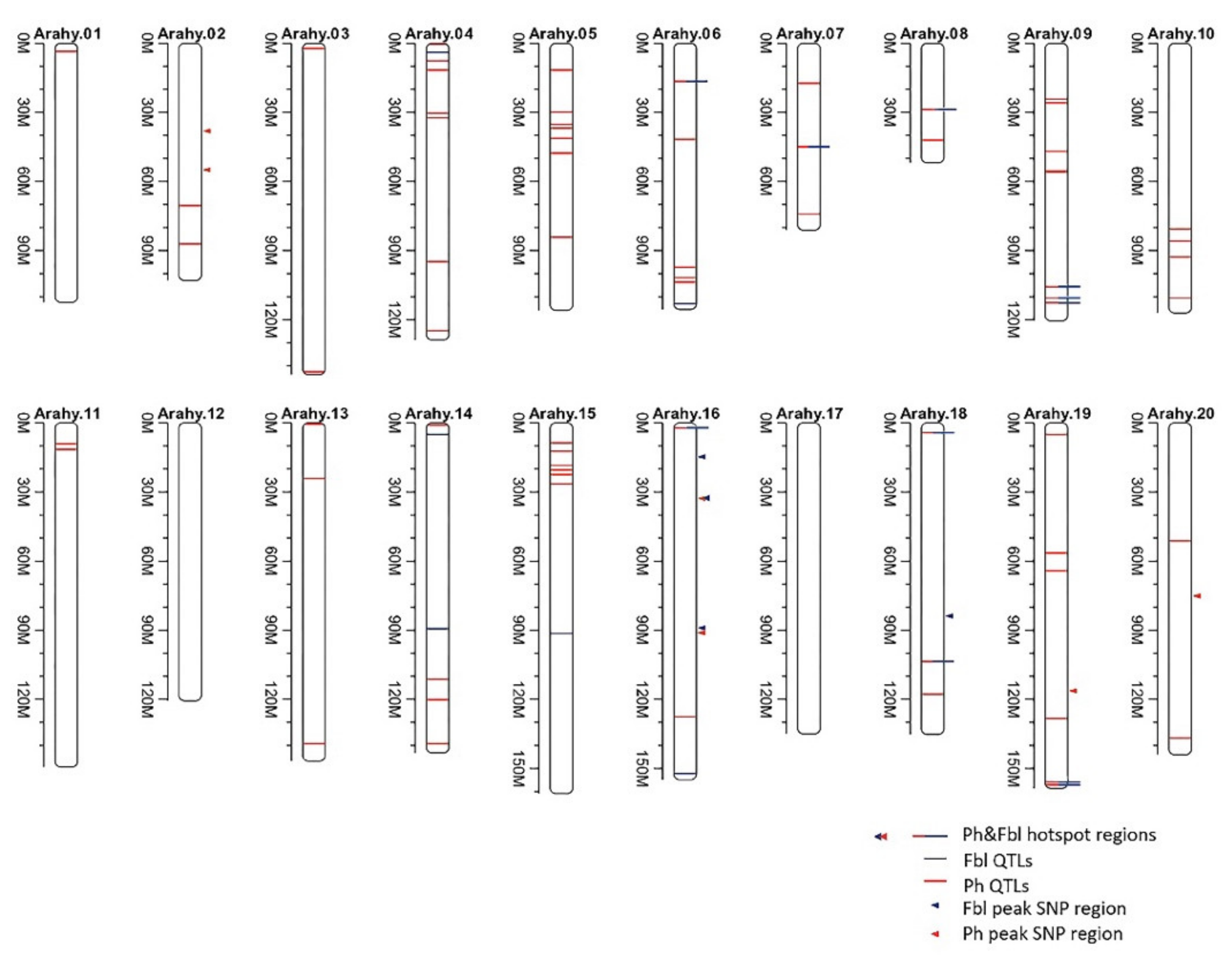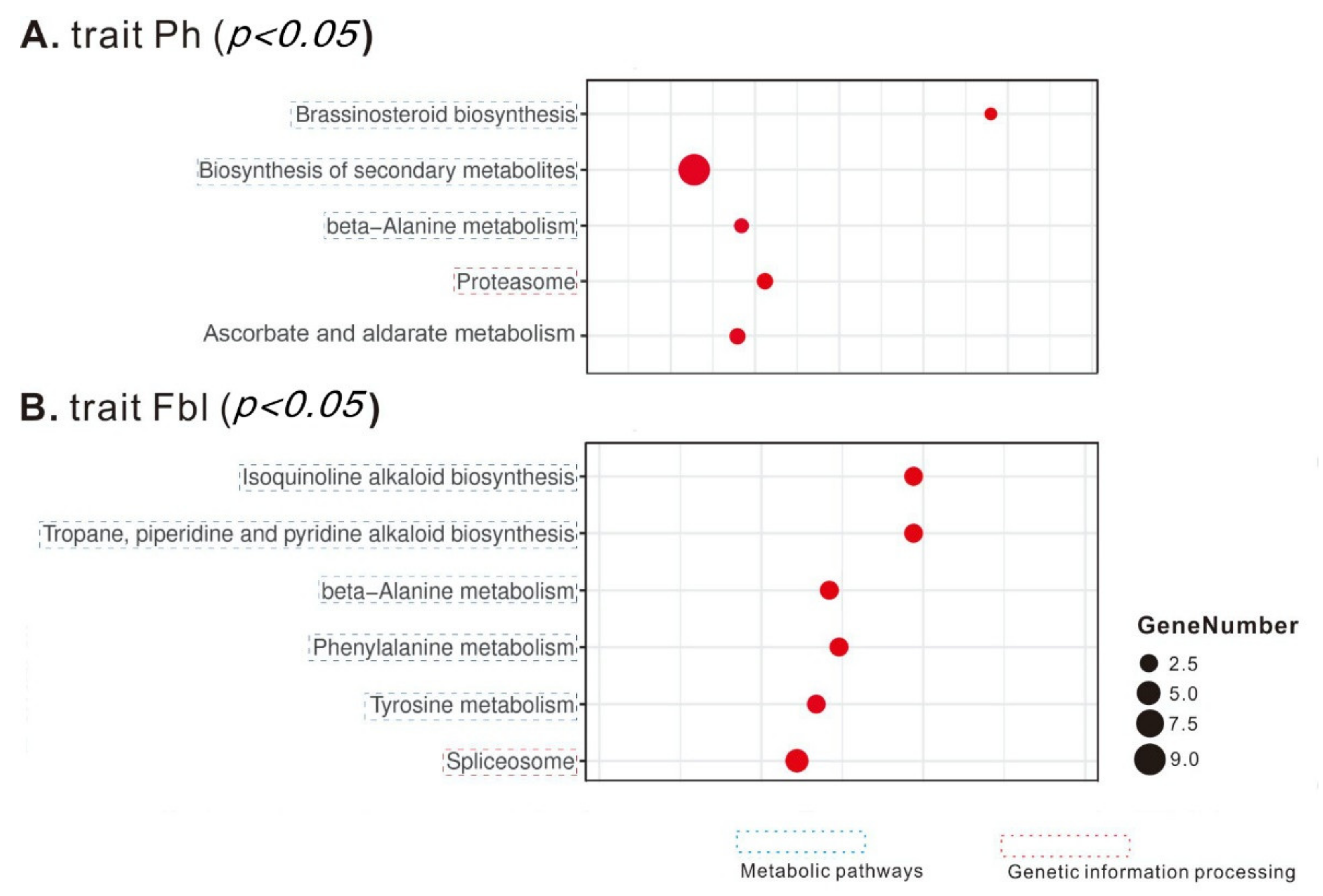The Genetic Base for Peanut Height-Related Traits Revealed by a Meta-Analysis
Abstract
1. Introduction
2. Results
2.1. Characterisation and Distribution of Genetic Variations of the Peanut Genome
2.2. Phenotypic Correlation and Heritability for Different Traits
2.3. Genome-Wide Association Study (GWAS) in Peanut
2.4. A Summary of QTLs, for Peanut Ph and Fbl, Identified from Both Present and Earlier Studies
3. Discussion
4. Materials and Methods
4.1. Plant Materials
4.2. Phenotypic Statistics
4.3. Genome-Wide SNP Collection
4.4. Genome-Wide Association Study Analysis
4.5. A Literature Survey of QTLs for Peanut-Height Related Traits
Supplementary Materials
Author Contributions
Funding
Data Availability Statement
Acknowledgments
Conflicts of Interest
References
- Bertioli, D.J.; Cannon, S.B.; Froenicke, L.; Huang, G.; Farmer, A.D.; Cannon, E.K.; Liu, X.; Gao, D.; Clevenger, J.; Dash, S.; et al. The genome sequences of Arachis duranensis and Arachis ipaensis, the diploid ancestors of cultivated peanut. Nat. Genet. 2016, 48, 438–446. [Google Scholar] [CrossRef] [PubMed]
- Bertioli, D.J.; Jenkins, J.; Clevenger, J.; Dudchenko, O.; Gao, D.; Seijo, G.; Leal-Bertioli, S.C.M.; Ren, L.; Farmer, A.D.; Pandey, M.K.; et al. The genome sequence of segmental allotetraploid peanut Arachis hypogaea. Nat. Genet. 2019, 51, 877–884. [Google Scholar] [CrossRef] [PubMed]
- Stalker, H.T. Utilizing wild species for peanut improvement. Crop. Sci. 2017, 57, 1102–1120. [Google Scholar] [CrossRef]
- Yu, S.L. Peanut Genetics and Breeding in China; Shanghai Science and Technology Press: Shanghai, China, 2011; pp. 11–13. [Google Scholar]
- Varshney, R.K.; Nayak, S.N.; May, G.D.; Jackson, S.A. Next-generation sequencing technologies and their implications for crop genetics and breeding. Trends Biotechnol. 2009, 27, 522–530. [Google Scholar] [CrossRef] [PubMed]
- Varshney, R.K.; Mohan, S.M.; Gaur, P.M.; GangaRao, N.; Pandey, M.K.; Bohra, A.; Sawargaonkar, S.L.; Chitikineni, A.; Kimurto, P.K.; Janila, P.; et al. Achievements and prospects of genomics-assisted breeding in three legume crops of the semi-arid tropics. Biotechnol. Adv. 2013, 31, 1120–1134. [Google Scholar] [CrossRef]
- Khedikar, Y.; Pandey, M.K.; Sujay, V.; Singh, S.; Nayak, S.N.; Klein-Gebbinck, H.W.; Sarvamangala, C.; Mukri, G.; Garg, V. Identification of main effect and epistatic quantitative trait loci for morphological and yield-related traits in peanut (Arachis hypogaea L.). Mol. Breeding 2018, 38, 1–12. [Google Scholar]
- Cheng, L.Q.; Tang, M.; Ren, X.P.; Huang, L.; Chen, W.; Li, Z.; Zhou, X.; Chen, Y.; Liao, B.; Jiang, H. Construction of genetic map and QTL analysis for mian stem height and total branch number in peanut. Acta Agrono. Sin. 2015, 41, 979–987. [Google Scholar] [CrossRef]
- Huang, L.; He, H.; Chen, W.; Ren, X.; Chen, Y.; Zhou, X.; Xia, Y.; Wang, X.; Jiang, X.; Liao, B.; et al. Quantitative trait locus analysis of agronomic and quality-related traits in cultivated peanut (Arachis hypogaea L.). Theor. Appl. Genet. 2015, 128, 1103–1115. [Google Scholar] [CrossRef]
- Lan, X.L.; Tang, Z.X.; Xu, R. Analysis of gray gorrelation between yield and major agronomic traits of peanut in Fujian Province. Acta Agric. Jiangxi 2011, 23, 61–63. [Google Scholar] [CrossRef]
- Yin, D.M.; Shang, M.Z.; Cui, D.Q. Studies on genetic analysis of major agronomic characters in peanut. Chin. Agric. Sci. Bull. 2006, 22, 261–265. [Google Scholar]
- Kover, P.X.; Valdar, W.; Trakalo, J.; Scarcelli, N.; Ehrenreich, I.M.; Purugganan, M.D.; Durrant, C.; Mott, R. A Multiparent Advanced Generation Inter-Cross to Fine-Map Quantitative Traits in Arabidopsis thaliana. PLoS Genet. 2009, 5, e1000551. [Google Scholar] [CrossRef] [PubMed]
- Zhang, S.Z.; Qiu, J.L.; Miao, H.R.; Yang, W.Q.; Zhao, L.B.; Song, X.; Pan, L.J.; Zhang, Z.M.; Hu, X.H.; Chen, J.; et al. QTL mapping for main stem height, first branch length and branch number based on a high-density linkage map in peanut (Arachis hypogaea L.). J. Peanut Sci. 2019, 48, 1–9. [Google Scholar]
- Lv, J.; Liu, N.; Guo, J.; Xu, Z.; Li, X.; Li, Z.; Luo, H.; Ren, X.; Huang, L.; Zhou, X.; et al. Stable QTLs for Plant Height on Chromosome A09 Identified from Two Mapping Populations in Peanut (Arachis hypogaea L.). Front. Plant Sci. 2018, 9, 684. [Google Scholar] [CrossRef] [PubMed]
- Chen, W.-G.; Guo, J.-B.; Xu, Z.-J.; Yu, B.-L.; Qiu, X.-K.; Huang, L.; Song, Y.-B.; Chen, Y.-N.; Zhou, X.-J.; Luo, H.-Y.; et al. QTL Mapping for Shelling Percentage and Plant Height in Cultivated Peanut (Arachis hypogaea L.). Acta Agron. Sin. 2018, 44, 1142–1151. [Google Scholar] [CrossRef]
- Li, Y.; Li, L.; Zhang, X.; Zhang, K.; Ma, D.; Liu, J.; Wang, X.; Liu, F.; Wan, Y. QTL mapping and marker analysis of main stem height and the first lateral branch length in peanut (Arachis hypogaea L.). Euphytica 2017, 213, 57. [Google Scholar] [CrossRef]
- Li, Y.J. QTL Analysis for Plant Height, Total Branching Number and Pod Traits in Peanut (Arachis hypogaea L.). Master’s Thesis, Shandong Agricultural University, Shandong, China, 2016. [Google Scholar]
- Wang, J.; Yan, C.X.; Li, Y.; Li, C.; Zhao, X.; Yuan, C.; Sun, Q.; Shan, S. GWAS discovery of candidate genes for yield-related traits in peanut and support from earlier QTL mapping studies. Genes 2019, 10, 803. [Google Scholar] [CrossRef]
- De Abreu, I.N.; Mazzafera, P. Effect of water and temperature stress on the content of active constituents of Hypericum brasiliense Choisy. Plant Physiol. Biochem. 2005, 43, 241–248. [Google Scholar] [CrossRef]
- Song, W.; Forderer, A.; Yu, D.L.; Chai, J.J. Structural biology of plant defense. New Phytol. 2021, 229, 692–711. [Google Scholar] [CrossRef]
- Liu, P.-L.; Du, L.; Huang, Y.; Gao, S.-M.; Yu, M. Origin and diversification of leucine-rich repeat receptor-like protein kinase (LRR-RLK) genes in plants. BMC Evol. Biol. 2017, 17, 47. [Google Scholar] [CrossRef]
- Chakraborty, S.; Nguyen, B.; Wasti, S.D.; Xu, G. Plant Leucine-Rich Repeat Receptor Kinase (LRR-RK): Structure, Ligand Perception, and Activation Mechanism. Molecules 2019, 24, 3081. [Google Scholar] [CrossRef]
- Shan, S.H.; Yan, C.X. Key Germplasms of Chinese Peanut Landraces; China Agriculture Press: Beijing, China, 2018. [Google Scholar]
- Zhang, H. Construction of Core Collections and Genetic Diversity Analysis of Arachis hypogaea L., Cultivars in China. Master’s Thesis, ZhongKai University of Agriculture and Engineering, Guangzhou, China, 2013. [Google Scholar]
- Ncube, B.; Van Staden, J. Tilting Plant Metabolism for Improved Metabolite Biosynthesis and Enhanced Human Benefit. Molecules 2015, 20, 12698–12731. [Google Scholar] [CrossRef] [PubMed]
- Benderoth, M.; Textor, S.; Windsor, A.; Mitchell-Olds, T.; Gershenzon, J.; Kroymann, J. Positive selection driving diversification in plant secondary metabolism. Proc. Natl. Acad. Sci. USA 2021, 103, 9118–9123. [Google Scholar] [CrossRef]
- Kroymann, J. Natural diversity and adaptation in plant secondary metabolism. Curr. Opin. Plant Biol. 2011, 14, 246–251. [Google Scholar] [CrossRef] [PubMed]
- Rhodes, M.J.C. Physiological roles for secondary metabolites in plants: Some progress, many outstanding problems. Plant Mol. Biol. 1994, 24, 1–20. [Google Scholar] [CrossRef]
- Isah, T. Stress and defense responses in plant secondary metabolites production. Biol. Res. 2019, 52, 39. [Google Scholar] [CrossRef]
- Selmar, D.; Kleinwächter, M. Stress enhances the synthesis of secondary plant products: The impact of stress-related over-reduction on the accumulation of natural products. Plant Cell Physiol. 2013, 54, 817–826. [Google Scholar] [CrossRef] [PubMed]
- Yahyazadeh, M.; Meinen, R.; Hänsch, R.; Abouzeid, S.; Selmar, D. Impact of drought and salt stress on the biosynthesis of alkaloids in Chelidonium majus L. Phytochemistry 2018, 152, 204–212. [Google Scholar] [CrossRef]
- Parthasarathy, A.; Savka, M.A.; Hudson, A.O. The Synthesis and Role of β-Alanine in Plants. Front. Plant Sci. 2019, 10, 921. [Google Scholar] [CrossRef]
- Klapheck, S.; Zopes, H.; Bergmann, L.; Levels, H.-G. Properties and localization of the homoglutathione synthetase from Phaseolus coccineus leaves. Physiol. Plant. 1988, 74, 733–739. [Google Scholar] [CrossRef]
- Nolan, T.M.; Vukašinović, N.; Liu, D.; Russinova, E.; Yin, Y. Brassinosteroids: Multidimensional Regulators of Plant Growth, Development, and Stress Responses. Plant Cell 2020, 32, 295–318. [Google Scholar] [CrossRef]
- Gest, N.; Gautier, H.; Stevens, R. Ascorbate as seen through plant evolution: The rise of a successful molecule? J. Exp. Bot. 2013, 64, 33–53. [Google Scholar] [CrossRef]
- Zhou, Y.; Gao, Y.; Xu, C.; Shen, H.; Tian, Q.; Deng, H.-W. A novel approach for correction of crosstalk effects in pathway analysis and its application in osteoporosis research. Sci. Rep. 2018, 8, 668. [Google Scholar] [CrossRef]
- Jiang, H.F.; Duan, N.; Ren, X.P. Descriptors and Data Standard for Peanut (Arachis spp.); China Agriculture Press: Beijing, China, 2006. [Google Scholar]
- Li, H.; Durbin, R. Fast and accurate short read alignment with Burrows-Wheeler transform. Bioinformatics 2009, 25, 1754–1760. [Google Scholar] [CrossRef] [PubMed]
- Wang, K.; Li, M.; Hakonarson, H. ANNOVAR: Functional annotation of genetic variants from high-throughput sequencing data. Nucleic Acids Res. 2010, 38, e164. [Google Scholar] [CrossRef] [PubMed]
- Bradbury, P.J.; Zhang, Z.; Kroon, D.E.; Casstevens, T.M.; Ramdoss, Y.; Buckler, E.S. Tassel: Soft-ware for association mapping of complex traits in diverse samples. Bioinformatics 2007, 23, 2633–2635. [Google Scholar] [CrossRef]
- Glaubitz, J.; Casstevens, T.; Lu, F. TASSEL-GBS: A high capacity genotyping by sequencing analysis pipe-line. PLoS ONE 2013, 9, e90346. [Google Scholar]
- Zhang, X.; Zhang, J.; He, X.; Wang, Y.; Ma, X.; Yin, D. Genome-Wide Association Study of Major Agronomic Traits Related to Domestication in Peanut. Front. Plant Sci. 2017, 8, 1611. [Google Scholar] [CrossRef]
- Hardy, O.J.; Vekemans, X. SPAGeDi: A versatile computer program to analyses spatial genetic structure at the individual or population levels. Mol. Ecol. Resour. 2002, 2, 618–620. [Google Scholar] [CrossRef]
- Huang, D.W.; Sherman, B.T.; Lempicki, R.A. Bioinformatics enrichment tools: Paths toward the comprehensive functional analysis of large gene lists. Nucleic Acids. Res. 2009, 37, 1–13. [Google Scholar] [CrossRef] [PubMed]




| Trait | Sample | Mean | SD | SE | Median | Min | Max | Range | Skew | Kurtosis | CV% | H2 |
|---|---|---|---|---|---|---|---|---|---|---|---|---|
| Fbl | 1422 | 48.61386 | 13.4337 | 0.356243 | 48.2 | 11.6 | 87.8 | 76.2 | 0.22002 | −0.35783 | 27.63 | 0.513899 |
| Nsk | 1423 | 17.47671 | 4.318244 | 0.114473 | 17.4 | 5.2 | 30.4 | 25.2 | 0.037926 | −0.18738 | 24.71 | 0.443737 |
| Ph | 1417 | 35.078 | 10.65981 | 0.283181 | 34.0 | 6.6 | 67.8 | 61.2 | 0.450744 | −0.11826 | 30.39 | 0.473302 |
Publisher’s Note: MDPI stays neutral with regard to jurisdictional claims in published maps and institutional affiliations. |
© 2021 by the authors. Licensee MDPI, Basel, Switzerland. This article is an open access article distributed under the terms and conditions of the Creative Commons Attribution (CC BY) license (https://creativecommons.org/licenses/by/4.0/).
Share and Cite
Wang, J.; Yan, C.; Shi, D.; Zhao, X.; Yuan, C.; Sun, Q.; Mou, Y.; Chen, H.; Li, Y.; Li, C.; et al. The Genetic Base for Peanut Height-Related Traits Revealed by a Meta-Analysis. Plants 2021, 10, 1058. https://doi.org/10.3390/plants10061058
Wang J, Yan C, Shi D, Zhao X, Yuan C, Sun Q, Mou Y, Chen H, Li Y, Li C, et al. The Genetic Base for Peanut Height-Related Traits Revealed by a Meta-Analysis. Plants. 2021; 10(6):1058. https://doi.org/10.3390/plants10061058
Chicago/Turabian StyleWang, Juan, Caixia Yan, Dachuan Shi, Xiaobo Zhao, Cuiling Yuan, Quanxi Sun, Yifei Mou, Haoning Chen, Yuan Li, Chunjuan Li, and et al. 2021. "The Genetic Base for Peanut Height-Related Traits Revealed by a Meta-Analysis" Plants 10, no. 6: 1058. https://doi.org/10.3390/plants10061058
APA StyleWang, J., Yan, C., Shi, D., Zhao, X., Yuan, C., Sun, Q., Mou, Y., Chen, H., Li, Y., Li, C., & Shan, S. (2021). The Genetic Base for Peanut Height-Related Traits Revealed by a Meta-Analysis. Plants, 10(6), 1058. https://doi.org/10.3390/plants10061058






